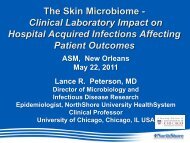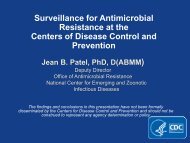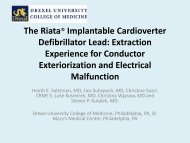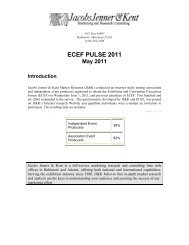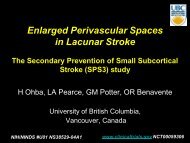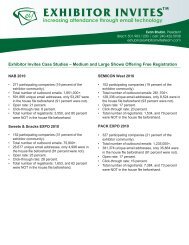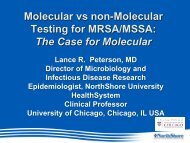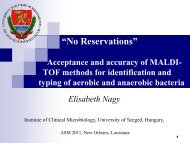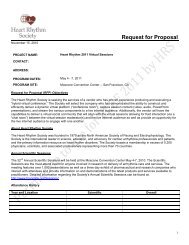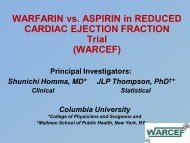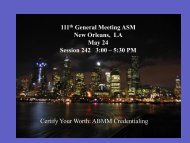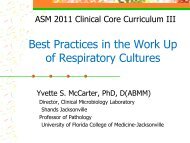ABMM/ABMLI Professional Recognition Award
ABMM/ABMLI Professional Recognition Award
ABMM/ABMLI Professional Recognition Award
Create successful ePaper yourself
Turn your PDF publications into a flip-book with our unique Google optimized e-Paper software.
<strong>ABMM</strong>/<strong>ABMLI</strong> <strong>Professional</strong><br />
<strong>Recognition</strong> <strong>Award</strong><br />
Patrick R. Murray, PhD<br />
May 22, 2011
Clinical Microbiology:<br />
The Future is in Good Hands<br />
• My mentors and their influence<br />
• Contributions of fellows working in<br />
my NIH lab<br />
• The future of clinical microbiology
John Washington<br />
1936-2010<br />
Henry Isenberg<br />
1922-2006<br />
My Mentors<br />
Alex Sonnenwirth<br />
1923-1984<br />
Al Balows<br />
1921-2006
NIH Microbiology Fellows<br />
• 2001-2003 Pattarachai Kiratisin, MD, PhD<br />
• 2003-2006 Adrian Zelazny, PhD<br />
• 2004-2006 Susan Harrington, PhD<br />
• 2006-2009 Clemente Montero, PhD<br />
• 2007-2009 Lindsay Stevenson, PhD<br />
• 2008-present Lilia Mijares, PhD<br />
• 2011-present Anna Lau, PhD<br />
• 2011-present Stella Antonara, PhD
• Bangkok, Thailand<br />
• MD, Mahidol University<br />
Pattarachai Kiratisin, MD, PhD<br />
• PhD, University of Rochester Medical<br />
Center, New York<br />
• NIH Microbiology Fellow (2001-03)<br />
• Recipient of ASM Dade MicroScan<br />
Young Investigator <strong>Award</strong> (2004)<br />
• Chairman of Clinical Microbiology<br />
Society of Thailand<br />
• Professor, Mahidol University and<br />
Deputy Chairman, Faculty of Medicine,<br />
Siriraj Hospital, Bangkok Thailand
Bacterial Identification by Gene Sequencing<br />
• Initiated the program for identification of bacteria by Sanger<br />
sequencing of 16S rRNA gene.<br />
• March 2002 – May 2003: 5% of all bacterial isolates identified<br />
by sequencing including –<br />
Abiotrophia defectiva Capnocytophaga sputigena Helicobacter cinaedi<br />
Achromobacter<br />
xylosoxidans<br />
Cardiobacterium hominis Herbaspirillum huttiense<br />
Brevundimonas diminuta Corynebacterium accolens Kingella denitrificans<br />
Campylobacter fetus Dysgonomonas capnocytophagoides Kytococcus schroeteri<br />
Campylobacter upsaliensis Haemophilus aphrophilus Tsukamurella pulmonis<br />
• Following year, determined that sequencing the housekeeping<br />
genes for glucose-6-phosphate dehydrogenase and glucose<br />
kinase could be used to identify members of the<br />
Streptococcus mitis group.
• Born Buenos Aires, Argentina<br />
• PhD, Weizmann Institute, Israel<br />
Adrian Zelazny, PhD<br />
• NIH Microbiology Fellow (2003-06)<br />
• Recipient of NIH Fellows <strong>Award</strong> for<br />
Research Excellence (2005)<br />
• Fellow, <strong>ABMM</strong> (2006)<br />
• NIH Director’s <strong>Award</strong> for Research<br />
(2007)<br />
• Recipient of ASM Dade MicroScan<br />
Young Investigator <strong>Award</strong> (2008)<br />
• Staff Scientist, NIH Clinical<br />
Microbiology Laboratory
Identification of Mycobacterium<br />
and Nocardia Species by Gene Sequencing<br />
• A number of gene targets had been used to identify<br />
mycobacteria and nocardia with variable success including<br />
16S rRNA, 16S-23S internal transcribed spacer, heat shock<br />
protein, recA, rpoB, and gyrB genes.<br />
• Speculated that since SecA1 protein is essential for protein<br />
export, secA1 gene would be a good target for identification<br />
of these genera.
Identification of Mycobacterium Species<br />
• Identified the 700-bp gene sequence that codes the substrate<br />
specificity domain and protein translocation domain of the<br />
secA1 gene.<br />
• 47 reference strains representing 30 species and 59 clinical<br />
isolates representing 9 species were evaluated.<br />
• Variability of the target sequence allowed differentiation of all<br />
species except members of the M. tuberculosis complex<br />
which had identical sequences.<br />
• Strains belonging to the same species had high intraspecies<br />
similarity and all strains were correctly identified.
Identification of Nocardia Species<br />
• A similar study was performed with reference strains and<br />
clinical isolates of Nocardia.<br />
• 30 reference strains (30 species) and 40 clinical isolates<br />
representing 12 species were evaluated.<br />
• All 30 species could be differentiated by sequence analysis of<br />
the SecA1 gene target. Additionally, all clinical isolates were<br />
identified accurately using this gene target.<br />
• Subsequent studies have demonstrated that multiple gene<br />
targets may be necessary for the identification of some<br />
uncommonly isolated species.
Direct Detection and Identification<br />
of Mycobacteria and Nocardia in Clinical Specimens<br />
• All acid-fast organisms in smear-positive clinical<br />
specimens were identified directly by sequencing the<br />
SecA1 gene.<br />
• This approach was used in the last 5 years to identify<br />
mycobacteria and nocardia in clinical specimens from<br />
more than patients.<br />
• 17 species of mycobacteria (including M. tuberculosis,<br />
M. bovis, M. leprae) and 3 species of Nocardia were<br />
identified in many different specimens (e.g., respiratory,<br />
CSF, synovial fluid, duodenal fluid, skin lesions, sinus<br />
aspirates, urine, and tissues).
Susan Harrington, PhD<br />
• PhD, Department of Microbiology,<br />
University of Maryland School of<br />
Medicine<br />
• NIH Microbiology Fellow (2004-06)<br />
• Fellow, <strong>ABMM</strong> (2007)<br />
• Former Associate Director,<br />
Microbiology Laboratory, Albany<br />
Medical Center, New York<br />
• Current position: Cleveland Clinic -<br />
Associate Medical Director,<br />
Mycobacteriology & Specimen<br />
Processing
Genotypic Analysis of Invasive S. pneumoniae<br />
Strains from Mali Africa<br />
• Previous work demonstrated that 78% of the S. pneumoniae<br />
strains responsible for IPD in Mali were not in PCV7.<br />
• Used PFGE and repPCR to determine if clonal dissemination<br />
of predominant serotypes had occurred.<br />
• The two methods were equally discriminatory within a<br />
specific pneumococcal serotype.<br />
• Using both methods, isolates within serotypes 2, 5 and 7<br />
(the most common serotypes) formed 3 large clusters<br />
containing 1 genotype each, which is consistent with clonal<br />
dissemination of these serotypes.
• Born Venezuela<br />
Clemente Montero, PhD<br />
• PhD, Department of Chemical<br />
and Biomolecular Engineering,<br />
North Carolina State University<br />
• NIH Microbiology Fellow (2006-<br />
09)<br />
• Fellow, <strong>ABMM</strong> (2008)<br />
• Current position: Research<br />
Associate, Weill Medical College<br />
of Cornell University
Evaluation of Pyrosequencing for Yeast Identification
Evaluation of Pyrosequencing for Yeast Identification<br />
• 133 isolates of clinically relevant yeasts, representing 43<br />
species, were analyzed by gene sequencing.<br />
• Sanger cycle sequencing of the ITS1-5.8S-ITS2 region<br />
identified 79% of the isolates at the species level.<br />
• Pyrosequencing of the hyper-variable ITS region identified<br />
69% of the isolates at the species level.<br />
• Although most species of Candida could be identified<br />
accurately by pyrosequencing, Trichosporon species and<br />
some Cryptococcus species could not be differentiated.
Lindsay Stevenson, PhD<br />
• PhD, Department of Microbiology<br />
and Molecular Genetics, Emory<br />
University<br />
• NIH Microbiology Fellow (2007-<br />
09)<br />
• Fellow, <strong>ABMM</strong> (2010)<br />
• Current position: CPT, US Army<br />
Assistant Chief, Infectious Disease<br />
Laboratory, Walter Reed Army<br />
Medical Center and Bethesda<br />
Naval Hospital, Washington, DC
Microbial Identification by Matrix Assisted Laser<br />
Desorption/Ionization Time of Flight (MALDI-TOF)<br />
Mass Spectrometry<br />
Intens.<br />
[a.u.]<br />
500<br />
0<br />
400<br />
0<br />
300<br />
0<br />
200<br />
0<br />
100<br />
0<br />
4364<br />
5096<br />
5380<br />
6254<br />
6315<br />
6410<br />
7157<br />
7273<br />
0<br />
4000 5000 6000 7000 8000<br />
7870<br />
8368<br />
m/z
MALDI-TOF Mass Spectrometry<br />
Technical Considerations<br />
• Most biomarkers detected in MALDI spectra are intracellular<br />
basic proteins (2000 to 25,000 Da).<br />
– Bacteria – ribosomal proteins<br />
– Fungi – ribosomal and mitochondrial proteins<br />
• Spectral profiles are influenced by culture conditions (e.g.,<br />
media, age of colonies), pre-analytic processing, and assay<br />
conditions.<br />
• Although reproducibility of spectra can be poor, unique<br />
profiles of conserved, discriminatory peaks are obtained and<br />
are sufficient to identify a wide spectrum of organisms.
MALDI-TOF Mass Spectrometry<br />
Yeast Identification<br />
• 194 clinical isolates were tested (6 genera, 23 species)<br />
• 192 (99.0%) were identified correctly; 2 isolates (Candida<br />
rugosa and Cryptococcus neoformans) had spectral scores<br />
MALDI-TOF Mass Spectrometry<br />
Identification of Isolates in Positive Blood Cultures<br />
• 212 positive blood cultures were analyzed:<br />
– 20% with no identification<br />
– 95% of the remaining organisms were identified<br />
correctly at the species level<br />
– 8 organisms were misidentified (all Streptococcus mitis<br />
isolates were misidentified as S. pneumoniae)<br />
• The most common organisms with no ID were<br />
Propionibacterium and coagulase-negative<br />
staphylococci
• PhD, Yale University School of<br />
Medicine<br />
Lilia Mijares, PhD<br />
• NIH Fellow in Clinical Microbiology<br />
Laboratory and National Human<br />
Genome Institute, Julie Segre lab<br />
(2008-present)
MALDI-TOF Mass Spectrometry<br />
Nocardia and Mycobacteria Identification<br />
• Techniques used to bacteria and yeasts failed to produce<br />
acceptable spectra for nocardia and mycobacteria.<br />
• A modified protein extraction procedure was developed<br />
using heat inactivation and mechanical steps to disperse<br />
bacteria and fragment their cell walls.<br />
• Databases were developed for 37 species of mycobacteria<br />
and 43 species of nocardia, and then challenged with >300<br />
strains of mycobacteria and nocardia.<br />
• M. tuberculosis complex strains were identified accurately<br />
at the complex level but could not be identified at the<br />
species level. All other strains were identified accurately at<br />
the species level.
MALDI-TOF Mass Spectrometry<br />
• Routinely used in the NIH lab for the<br />
identification:<br />
– Aerobic and anaerobic bacteria<br />
– Yeasts and limited selection of molds<br />
– Bacteria and yeasts recovered in blood culture broths<br />
– Nocardia and mycobacteria<br />
• Virtually all organisms identified at the species<br />
level unless:<br />
– Inoculum insufficient<br />
– Organism not adequately represented in database
Reflections<br />
• My career is rooted in mentors and colleagues who taught me<br />
the clinical significance of this discipline, the skills to critically<br />
analyze data and write my thoughts coherently, and the<br />
intricacies of managing a clinical lab; they gave me the<br />
opportunities and support to function at a national level;<br />
• I have benefitted most recently by being surrounded by<br />
fellows and colleagues who are willing to explore new<br />
approaches for improving diagnostic testing.<br />
• I think the future of clinical microbiology is bright because we<br />
have a new generation of microbiologists who have the<br />
training and intellectual skills to discover novel solutions to<br />
clinical problems.



